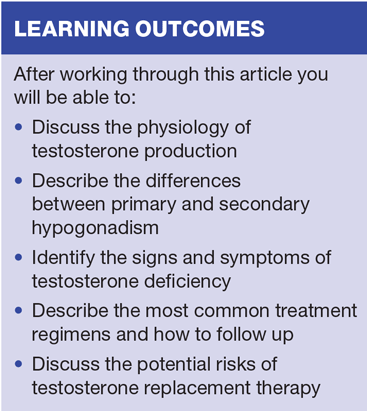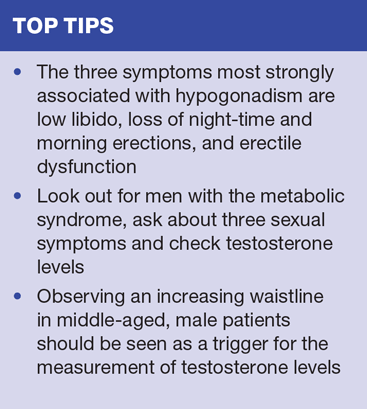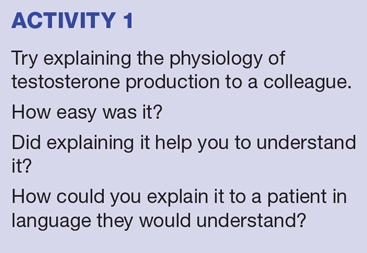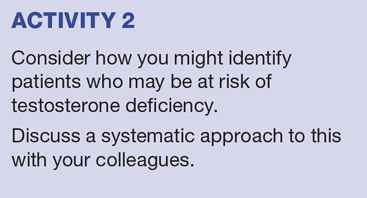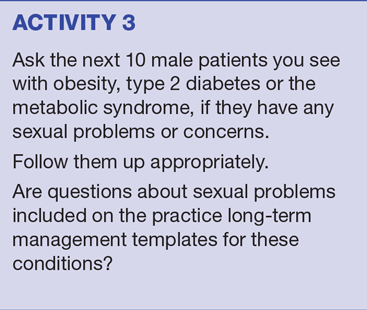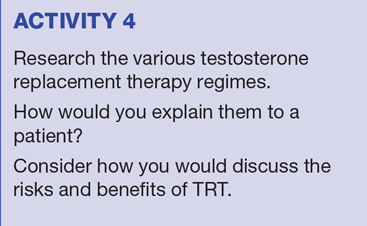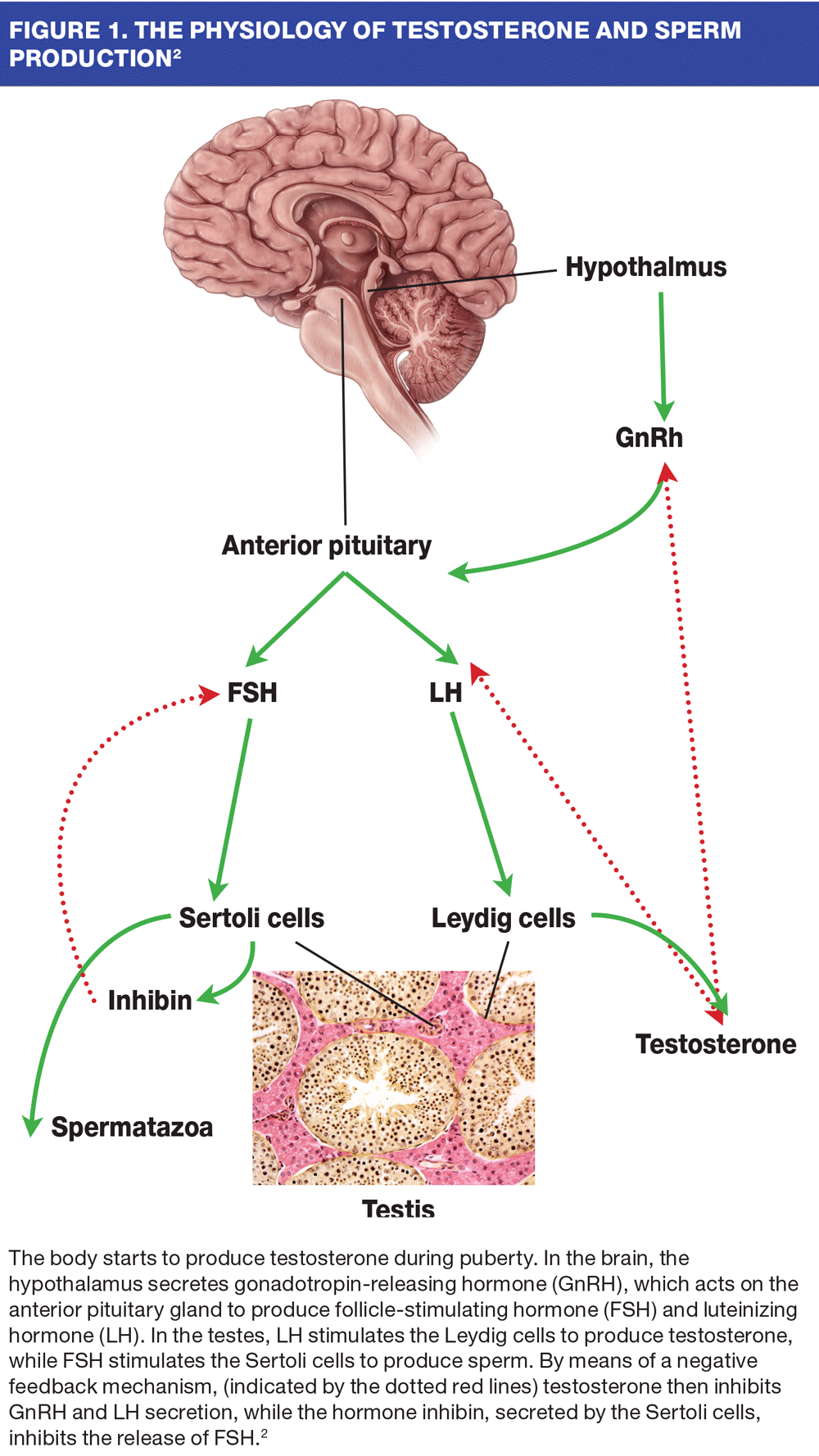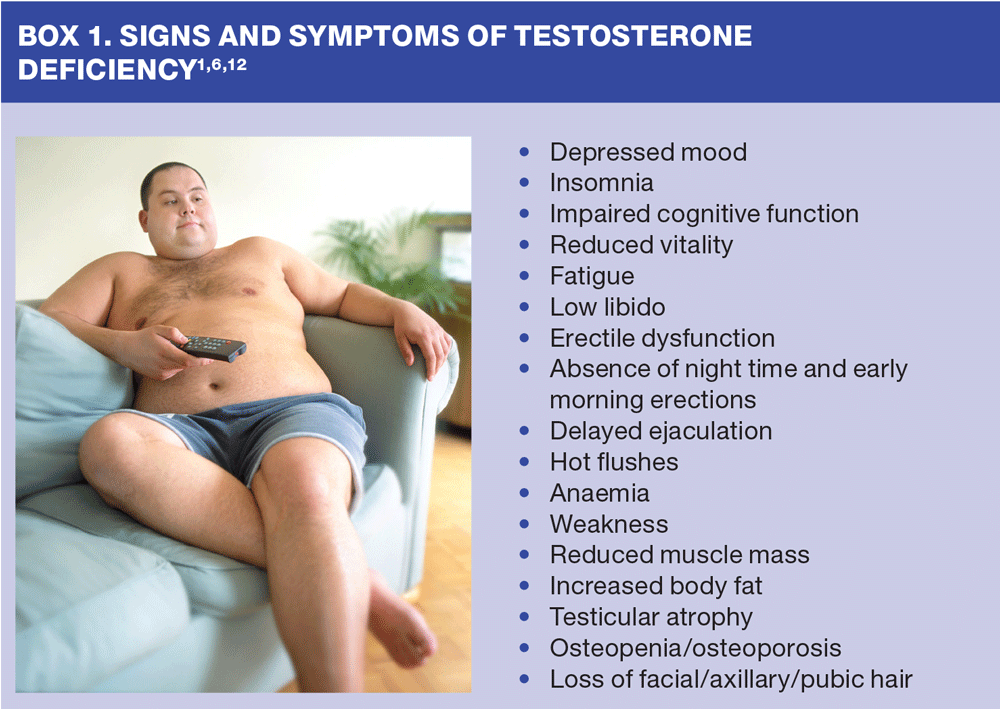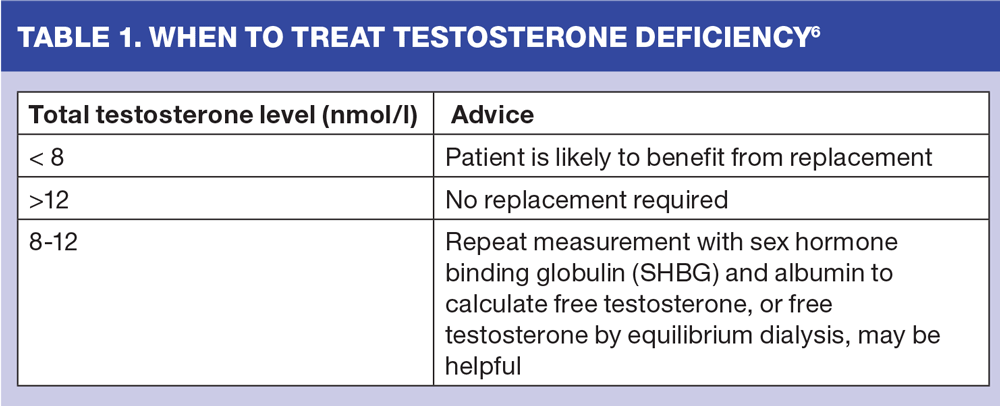Testosterone deficiency
Professor Mike Kirby
Professor Mike Kirby
MBBS FRCP
Visiting Professor, University of Hertfordshire and The Prostate Centre, London
The so-called male menopause may seem like a bit of a joke, but in reality declining testosterone levels in middle age and later life can have a significant impact on many aspects of male physiology, and frank testosterone deficiency can adversely affect a man’s health and quality of life. General practice nurses can play a key role in identifying patients at risk, confirming diagnosis and arranging follow up
Testosterone deficiency, also known as hypogonadism, is when the body is unable to make enough testosterone to function normally. Testosterone is the most important male sex hormone (androgen). It is essential for the development and maintenance of male characteristics, but it also has effects on sexual function and most major organs including the brain, skin, muscle, bone and kidneys. Low testosterone levels are associated with established cardiovascular disease (CVD) risk factors and an increased risk of death.1 Low testosterone can also significantly reduce a man’s quality of life. Common symptoms include erectile dysfunction (ED), low libido, loss of night time erections, tiredness and depression.
HYPOGONADISM – WHY IT OCCURS
Hypogonadism may be primary, secondary or mixed. Primary hypogonadism results from problems in the testes themselves, which causes primary testicular failure. This is associated with low testosterone levels, impaired sperm production and elevated FSH & LH levels. Secondary hypogonadism results from central defects of the hypothalamus or pituitary gland, which causes secondary testicular failure. This is associated with low testosterone levels and low or low to normal FSH & LH levels.3
Unlike the dramatic fall in female hormones experienced by women at the time of the menopause, testosterone levels in men decline gradually from the age of about 30, at a rate of around 1.5% per year. However, androgen secretion in men doesn’t usually stop altogether and testosterone levels remain highly variable with aging.4,5 Late onset hypogonadism (LOH) is associated with advancing age.
In older men, risk factors for hypogonadism include obesity, the metabolic syndrome, diabetes mellitus, chronic obstructive pulmonary disease (COPD), inflammatory arthritis, renal and HIV-related diseases, androgen deprivation therapy for prostate cancer, chronic opiate therapy, prostate disease and excessive alcohol consumption.6
Unhealthy diets and a lack of exercise means we are seeing increasing numbers of patients with obesity, type 2 diabetes and the metabolic syndrome. The nature of the link between these conditions and hypogonadism is likely to be multifactorial and differ between individuals. Increased visceral fat may contribute to hypogonadism through activity of an enzyme called aromatase, which converts testosterone to oestrogen.7 This hormone change contributes to the production of ‘man boobs’ which the men hate! Fat cells also synthesise the protein leptin, which switches off LH production and has been associated with reduced testosterone levels. Low-grade inflammation associated with the metabolic syndrome is also thought to contribute to reduced testosterone synthesis.8 In a vicious circle, androgen deficiency promotes the production of fat cells, particularly around the abdomen. It is also associated with impaired glucose tolerance, reduced insulin sensitivity, increased levels of total cholesterol, LDL-cholesterol and triglycerides, and reduced levels of HDL-cholesterol.9,10
PREVALENCE
Hypogonadism, primary or secondary, can affect men of any age. Although we know the prevalence increases with age, estimates of prevalence vary. The European Male Aging Study (EMAS) reported an overall prevalence of 2.1% in men aged 40-79 years and rates of 0.1% in 40-49 year olds, 0.6% in 50-59 year olds, 3.2% in 60-69 year olds and 5.1% in 70-79 year olds.12 In the UK, it is estimated that over 8% of men aged 50-79 years are hypogonadal.6
DIAGNOSIS
The signs and symptoms of testosterone deficiency are listed in Box 1. However, it is important to remember that many of these may be due to lifestyle factors or psychological issues rather than testosterone deficiency. For example, low libido, erectile dysfunction, depressed mood and insomnia may result from stress, anxiety and/or depression. Reduced vitality, fatigue, weakness, reduced muscle mass and increased body fat may result from a lack of exercise and/or a poor diet. A diagnosis of ‘treatable’ hypogonadism is therefore based on clinical signs and symptoms suggestive of testosterone deficiency in combination with biochemical evidence on blood testing.6 The likelihood of symptoms increases as levels of testosterone decrease.11
DIAGNOSTIC TESTING
To measure total testosterone, blood should be taken in the morning between 7-11am (preferably at 9am), using a reliable method on more than one occasion.6 Advice on when to treat is summarised in Table 1.
Measuring serum luteinizing hormone (LH) helps differentiate between primary and secondary hypogonadism.6
In clinical practice, hypogonadism in adult men is easily missed, even when there are associated symptoms, because these men often ignore their symptoms or attribute them to other causes such as aging.13 The most common presentation of hypogonadism stems from screening investigations for reduced sexual desire and/or ED. We know that hypogonadism is more likely to occur in men with certain conditions, so we should consider routinely asking those at high risk if they have any sexual problems.6 A typical question may be ‘Many men with diabetes have sexual difficulties, is this a concern for you?’
LOW TESTOSTERONE AND INCREASED MORTALITY
In addition to the signs and symptoms detailed previously, low testosterone levels are also associated with established CVD risk factors and an increased risk of death.1 The European Prospective Investigation into Cancer in Norfolk (EPIC-Norfolk) study compared 825 men without CVD and cancer at baseline who died within the 10 year follow-up period, with 1,489 men who were still alive. Increasing testosterone levels appeared to be inversely related to deaths due to all causes, CVD and cancer, with an approximately 25% – 30% lower risk of death found in the highest versus the lowest quartile of testosterone level. Furthermore, an increase of 6 nmol/l of testosterone was associated with an approximately 14% lower risk of death.14 In the EPIC study, testosterone levels were significantly associated with a number of CVD risk factors, and appeared to have positive effects on high density lipoprotein cholesterol (HDL-C), triglycerides, body mass index (BMI) and diabetes prevalence, and negative effects on total and low density lipoprotein cholesterol (LDL-C). However, the relationship between testosterone levels and these CVD risk factors remained unchanged after adjustment for these factors, which suggests that any protective cardiovascular effect was not mediated through them, and may instead have resulted from modulation of inflammatory markers or haemostatic factors, or from improved endothelial function and coronary vasodilation. The study authors concluded that low testosterone may be a predictive marker for those men at high risk of CVD,14 which highlights the importance of early identification and treatment.
Subgroup data from the European Male Aging Study (EMAS) was analysed to clarify the associations between LOH, low testosterone and sexual symptoms with mortality in 2,599 men aged 40-79 years from eight European countries. After adjusting for age, centre, BMI, current smoking and poor general health, the men with severe LOH had a 5-fold higher risk of all-cause mortality compared to those without LOH. Compared to men with normal endocrine function, the risk of death was 2-fold higher in men with a testosterone level less then 8 nmol/l (irrespective of symptoms) and 3-fold higher in those with three sexual symptoms (irrespective of serum testosterone levels). The study authors concluded that detecting low testosterone levels in aging men presenting with sexual symptoms offers an opportunity to identify a small subgroup of the population who are at particularly high risk of dying.15
TREATMENT
Proven testosterone deficiency requires testosterone replacement, either with daily testosterone gel or long-acting testosterone undecanoate injections every 3 months. The therapeutic goal is to achieve and maintain serum testosterone levels in the low to middle normal range of young adult men.16 Testosterone replacement therapy (TRT) may produce a wide range of benefits in men with hypogonadism, including improvements in:
- Bone density
- Muscle mass and body composition
- Red blood cell production
- Mood and cognitive function
- Libido and sexual function
- Cardiovascular disease
- Quality of life17
In men with sexual dysfunction, TRT may also improve the response to PDE-5 inhibitors, e.g. sildenafil. This is of particular relevance to men with type 2 diabetes, in whom the response to PDE-5 inhibitors alone may be little more than 50%.6
However, TRT is also associated with some potential risks. These include:
- Possible stimulation of prostate cancer if it is already present
- Possible worsening of the symptoms of benign prostatic hyperplasia (BPH) – but may also improve them
- Gynecomastia
- Reduced testicular size
- Infertility
- An increase in the number of red blood cells (increase in haematocrit)
- Increased blood viscosity
- Worsening of untreated sleep apnoea17
There have been concerns about TRT increasing the risk of prostate cancer. Studies have so far failed to fully resolve this issue, but have been reassuring.18 A PSA test prior to treatment is therefore essential. TRT is currently contraindicated in men with locally advanced or metastatic prostate cancer. Hypogonadal men treated for localised prostate cancer may be considered for TRT after a period of at least 2 years if there is no evidence of residual cancer.6
There have also been concerns about TRT worsening lower urinary tract symptoms (LUTS), but this appears not to be the case.19
Paradoxically, obese men may be more likely to develop adverse effects from treatment with testosterone, but often have the most to gain.6
When using TRT, the benefits of treatment must always be balanced against the possible risks. Patients should be made aware of the potential benefits and risks before treatment is started and carefully monitored during treatment.
MONITORING
Men on TRT must be carefully followed up with a testosterone blood test 2 hours after the gel is rubbed in or just before the next injection is due, plus PSA and haematocrit every 6 to 12 months once established on treatment.
CONCLUSION
Increases in life expectancy mean we need to maintain quality of life for longer. Both men and women can now expect to live around one-third of their lives with some form of hormone deficiency, which may cause other problems. We therefore need to distinguish between the natural aging process and aging amplifiers such as chronic illness and obesity.
Healthcare professionals should see an increasing waistline as a potential trigger for the measurement of testosterone levels. In addition to this, patients need to be involved in their own care and counselled on an ‘anti-aging programme’, with the aim of becoming more active, eating a healthier diet and watching their weight.
REFERENCES
1. Laughlin GA, Barrett-Connor E, Bergstrom J. Low serum testosterone and mortality in older men. J Clin Endocrinol Metab 2008;93(1):68-75.
2. Costanza LS. Physiology, 3rd edn. Philadelphia: Saunders-Elsevier, 2006. In: Dandona P, Rosenberg MT. A practical guide to male hypogonadism in the primary care setting. Int J Clin Pract 2010;64(6):682-696.
3. Bhasin S, Cunningham GR, Hayes FJ, et al. Testosterone therapy in adult men with androgen deficiency syndromes: an endocrine society clinical practice guideline. J Clin Endocrine Metab 2006;91:1995-2010.
4. Shores MM, Matsumoto AM, Sloan KL, Kivlahan DR. Low serum testosterone and mortality in male veterans. Arch Intern Med 2006;166:1660-5.
5. Shores MM, Matsumoto AM, Sloan KL, Kivlahan DR. Low serum testosterone and mortality in male veterans. Arch Intern Med 2006;166:1660-5.
6. British Society for Sexual Medicine. Guidelines on the management of sexual problems in men: the role of androgens. 2010. Available at: http://www.bssm.org.uk/
7. Cohen PG. Obesity in men: the hypogonadal estrogen receptor relationship and its effect on glucose homeostasis. Med Hypotheses 2008;70:358-360.
8. Gorbachinsky I, Akpinar H, Assimos D. Metabolic syndrome and urologic diseases. Rev Urol 2010;12(4):e157-80.
9. Kelly DM, Jones TH. Testosterone: a metabolic hormone in health and disease. J Endocrinol 2013;217:R25-45. (Abstract).
10. Traish AM, Abdou R, Kypreos KE. Androgen deficiency and atherosclerosis: the lipid link. Vascular Pharmacol 2009; 51:303-13 (Abstract).
11. Wu FCW, Tajar A, Beynon JM, et al. Identification of late-onset hypogonadism in middle aged and elderly men. N Engl J Med 2010;363:123-35.
12. Grober ED. Testosterone deficiency and replacement: Myths and realities. CUAJ 2014;8(7-8 Suppl 5):S145-7.
13. American Association of Clinical Endocrinologists. Medical guidelines for clinical practice for the evaluation and treatment of hypogonadism in adult male patients – 2002 update. Endocr Pract 2002; 8: 440–56.
14. Khaw KT, Dowsett M, Folkerd E, et al. Endogenous testosterone and mortality due to all-causes, cardiovascular disease and cancer in men. Circulation 2007;116:2694-2701.
15. Pye SR, Huhtaniemi IT, Finn JD, et al. Late-onset hypogonadism and mortality in aging men. J Clin Endocrinol Metab 2014;99$):1357-66 (Abstract).
16. Zitzmann M, Nieschlag E. Androgen receptor gene CAG repeat length and body mass index modulate the safety of long-term intramuscular testosterone undecanoate therapy in hypogonadism. J Clin Endocrinol 2007;92:3844-53.
17. Bassil N, Alkaade S, Morely JE. The benefits and risks of testosterone replacement therapy: a review. Ther Clin Risk Man 2009;5:427-448.
18. Klap J, Schmid M, Loughlin KR. The relationship between total testosterone levels and prostate cancer: A review of the continuing controversy. J Urol. 2014 Sep 23. pii: S0022-5347(14)04490-5. doi: 10.1016/j.juro.2014.07.123. [Epub ahead of print].
19. Francoman D, Ilacqua A, Bruzziches R, Lenzi A, Aversa A. Effects of 5-year treatment with testosterone undecanoate on lower urinary tract symptoms in obese men with hypogonadism and metabolic syndrome. Urology 2014;83:167-74.
Related articles
View all Articles
